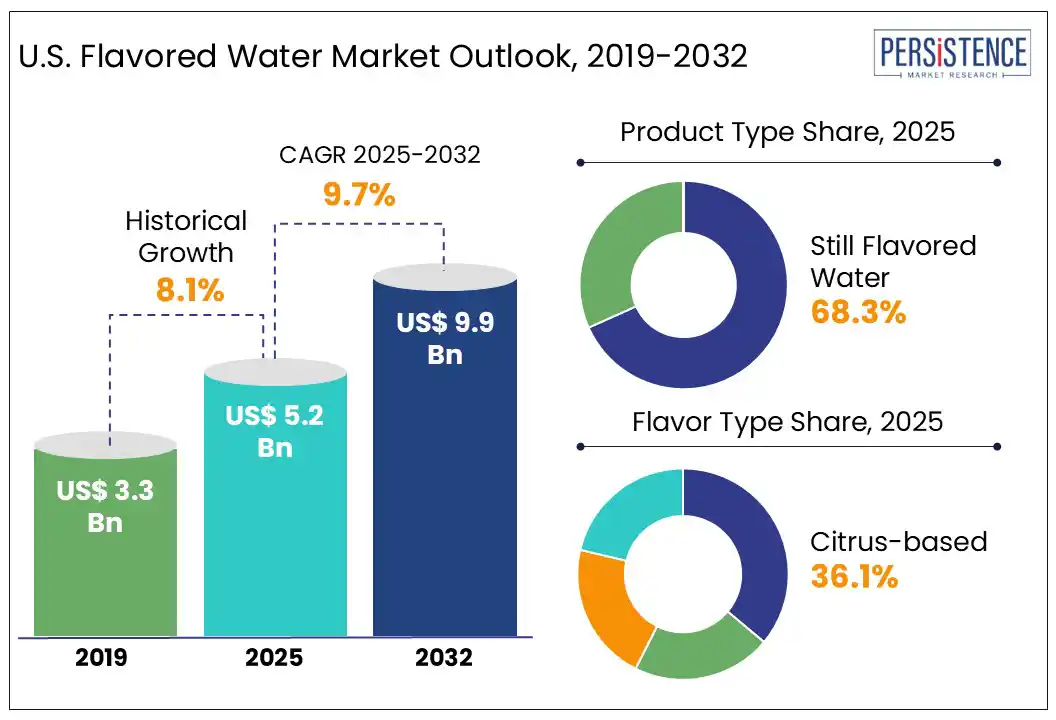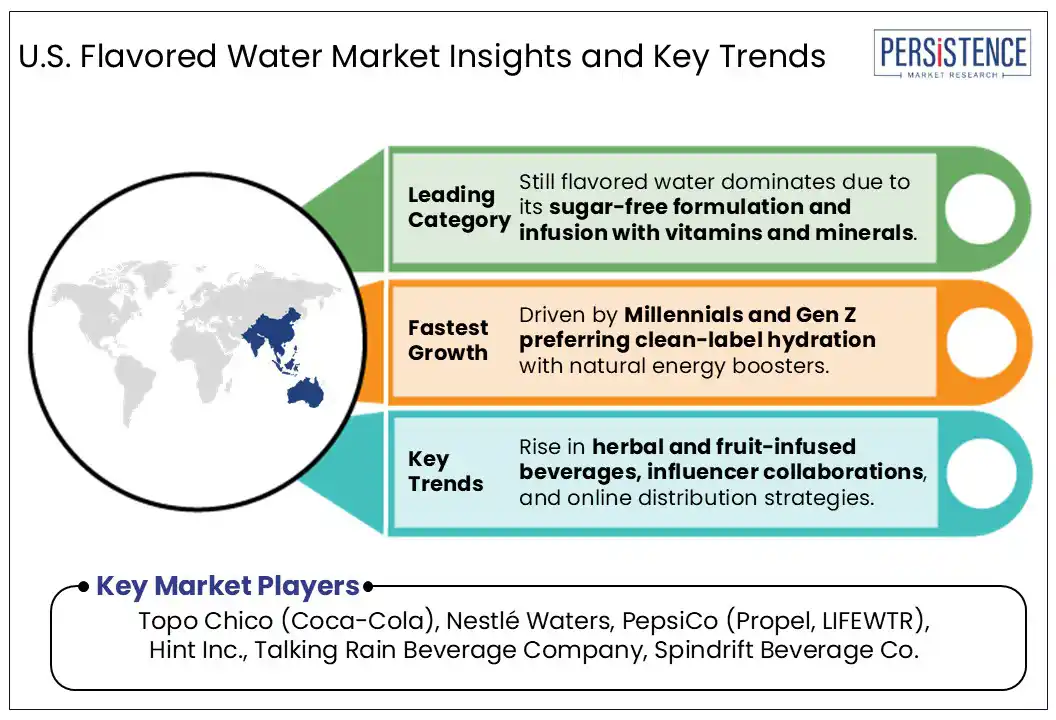ID: PMRREP35183| 185 Pages | 29 Jul 2025 | Format: PDF, Excel, PPT* | Food and Beverages

The U.S. flavored water market size is likely to be valued at US$ 5.2 Bn in 2025 and is estimated to reach US$ 9.9 Bn in 2032, growing at a CAGR of 9.7% during the forecast period 2025 - 2032. The U.S. flavored water market growth is driven by rising health consciousness, demand for low-calorie and clean-label beverages, and growing preference among younger consumers for natural, transparent, and convenient hydration options.
Consumers in the U.S. are now increasingly experimenting with beverages infused with healthy ingredients such as herbs and fruits. This trend has created a considerable demand for flavored water enriched with vitamins and minerals. As health-conscious population prefer quitting sugary sodas and artificial energy drinks, there is an increased preference for practical, transparent, and naturally sourced beverages that provide both hydration and long-lasting energy. Hence, brands are focusing on launching flavored water with exotic ingredients to attract target market.

Key Industry Highlights:
|
Market Attribute |
Key Insights |
|
U.S. Flavored Water Market Size (2025E) |
US$ 5.2 Bn |
|
Market Value Forecast (2032F) |
US$ 9.9 Bn |
|
Projected Growth (CAGR 2025 to 2032) |
9.7% |
|
Historical Market Growth (CAGR 2019 to 2024) |
8.1% |
Modern consumers concerned with ingredient transparency are choosing beverages free from artificial ingredients, preservatives, and high fructose corn syrup. This trend has a considerable influence on the U.S. flavored water industry, with businesses reformulating their products to meet increasing consumer demand for natural, sugar-free, and low-calorie alternatives.
According to surveys conducted, around 72% of respondents opted for sugar-free, zero-sugar, low-calorie, or natural beverages over traditional sugary drinks. This change is primarily propelled by growing awareness of obesity, diabetes, and other health problems associated with excessive sugar consumption. As a result, key brands are launching naturally sweetened and fruit-infused flavored water to align with changing consumer preferences. Recently, TREO launched organic flavored water sweetened with birch sap, erythritol, and stevia, with only one gram sugar. This product comes in several varieties such as Strawberry, Blueberry, Peach-Mango, and Raspberry Lemonade.
As transparency and well-being become more important, brands that focus on non-GMO, organic, and naturally enhanced formulas will continue to dominate the U.S. flavored water market. For instance, HydraDNA’s Collagen-Infused Sparkling Beverage, with 12 g collagen peptides, hydrating electrolytes, prebiotic fiber and 72 trace minerals, all in a sugar-free, naturally sweetened format, stands out as one of the most compelling U.S. launches in 2025.
The U.S. flavored water industry faces intense competition from energy drinks, sports drinks, and functional beverages, which offer hydration with added benefits such as caffeine, electrolytes, protein, and adaptogens. Consumers seeking an energy boost or post-workout recovery may choose these options over flavored water, restricting market growth.
Energy drinks, with their high caffeine content and performance-enhancing chemicals, appeal to young adults, athletes, and professionals seeking long-lasting energy. Brands such as Red Bull, Monster, and Celsius dominate this segment, diverting consumer focus away from flavored water. To compete, flavored water companies must differentiate themselves through premium formulations, clean-label ingredients, and sustainability initiatives.
Sponsoring fitness festivals, concerts, and athletic events offers an excellent opportunity for brands in the U.S. to increase product awareness and interact with consumers directly. These high-energy venues appeal to health-conscious, energetic, and social consumers, who are an important demographic for flavored water brands seeking to establish themselves as a go-to hydration option. Similarly, music festivals and concerts allow brands to integrate into young consumers’ lifestyle choices.
A notable example of this strategy is LaCroix’s College Brand Ambassador Program. It leverages student representatives to promote the brand at campus events, tailgates, and fitness activities. This grassroots marketing strategy helps develop brand loyalty among young customers, social media influencers, and trendsetters.
Citrus-based flavors such as lemon, lime, grapefruit, and orange are becoming popular as these provide a refreshing, crisp experience that enhances hydration. These are likely to generate a share of 36.1% in 2025. Various citrus-based flavored waters offer a balanced combination of acidity and mild sweetness, making these a popular choice for consumers looking for a natural and refreshing beverage.
Citrus flavors go well with other exotic and herbal infusions, leading to growth in flavor fusions such as lemon-ginger, lime-mint, and grapefruit-rose. As a result, flavored water companies continue to widen their citrus-based options to meet rising demand, linking citrus as the most popular option in the U.S. market. For instance, Spindrift’s Grapefruit sparkling water, made with real squeezed grapefruit, no added sugar, and praised for its authentic, clean citrus taste, stands out as a top choice of consumers.
Herbal and botanical flavors, on the other hand, are projected to exhibit a steady growth rate through 2032. The emergence of specialized formulations such as gut-health-supporting, energy-enhancing, detoxifying, and immune-boosting herb-infused water is set to create new opportunities. Brands are mainly utilizing rosemary, basil, and mint to prepare flavored water due to their excellent anti-inflammatory and digestive properties. For instance, Ayala’s Herbal Water uses organic herb infusions such as lemongrass-mint-vanilla, cinnamon-orange peel, lavender-mint, and cloves-cardamom-cinnamon. Firefly Tonics, available in the U.S., combines fruit juices with botanical extracts such as green tea, dandelion, nettle, yerba mate, and ginger in variants such as lemon lime and ginger.
Still flavored water is projected to account for a share of nearly 68.3% in 2025. Brands are launching a wide range of still water products infused with caffeine, vitamins, antioxidants, and minerals. Some consumers, especially athletes, often perceive sparkling flavored water as a reason to cause tooth decay and low bone mineral density. Hence, they are now shifting rapidly toward still waters. Hint and LIFEWTR offer caffeine, antioxidant, and vitamin-infused still waters tailored to athletes and health-conscious consumers who often avoid carbonation due to concerns such as tooth decay or low bone density.
Sparkling flavored water, on the other hand, is likely to see average growth through 2032 as the young demographic is looking for flavored fizzy and bubbly hydration products. Brands are anticipated to launch zero-sweetener and zero-calorie sparkling flavored waters in multiple fruit flavors across the U.S.

The U.S. flavored water market is highly competitive, with key players constantly innovating to meet customer demand for healthier, naturally flavored, and functional beverages. As customer preferences change, brands are adding sugar-free, clean-label, and exotic flavor infusions to their product lineups. To strengthen market presence, a few key players are investing in brand partnerships, influencer marketing, and event sponsorships, creating direct engagement with consumers.
Brands are innovating with functional ingredients such as vitamins and adaptogens, while emphasizing clean-label, sugar-free options and sustainable packaging such as recycled PET and compostable materials. Marketing strategies are focusing on influencer partnerships and experiential campaigns to engage consumers directly.
The market is estimated to be valued at US$ 5.2 Bn in 2025.
Growing demand is driven by customer preferences for healthier, sugar-free hydration options with natural flavors and functional benefits.
Citrus-based water is highly preferred among consumers in the U.S.
Nestlé, The Coca‑Cola Company, PepsiCo, Inc., and Primo Brands are a few key players.
The U.S. market will likely witness a CAGR of 9.7% from 2025 to 2032.
|
Report Attribute |
Details |
|
Historical Data/Actuals |
2019 - 2024 |
|
Forecast Period |
2025 - 2032 |
|
Market Analysis |
Value: US$ Bn |
|
Geographical Coverage |
|
|
Competitive Analysis |
|
|
Report Highlights |
|
|
Customization and Pricing |
Available upon request |
By Product Type
By Flavor Type
By Packaging Type
By Sales Channel
By Zone
Delivery Timelines
For more information on this report and its delivery timelines please get in touch with our sales team.
About Author